I kept returning to one piece in particular, a small colored drawing glued on a cardboard square. It was left undated and titled lightly in pencil at the bottom, “Negroes, Churches, Stars.” Ray had done it while at BMC. I had to lean in close to see a tiny landscape of mountains made up of primitive figures that gave way to churches with tiny crosses and a star-filled sky above. The African-style figures and the churches morphed into mountain-forms through a network of obsessively penciled-in bricks and stripes. Hands appeared as trees, folds of cloth became mountain ridges. The coloring—dark blues and earth-tone red and brown stains—added another layer to the miniature landscape. What I liked best was how Ray used the jagged edge of the paper to suggest a mountaintop. Having spent close to a decade up in the very same mountains, I appreciated the accurate “feel” this ad-libbed ridgeline carried.
Bill has written about the piece in an exhibition catalogue, remarking that Ray “pin-pricked the paper to make holes which represent a field of stars. The holes are not the first or last time he reifies nothingness, that is, he uses something to represent nothing, and uses absence to conjure up presence.” 5 For me the presence is Ray’s deep-seated awe for nature, for tradition and for the dark power of magic. Simply put, a northern flatlander like Ray was bowled over by this Appalachian mountain culture. He had been transplanted into a small garden of wild exotics but was looking out at a vast range filled with rhododendron.
skip to main |
skip to sidebar

+copy.jpg)
Ray Johnson, James Dean/Rimbaud, collage on cardboard, ca. 1956-58, 11 by 7.625 inches, Private Collection

Tesserae 2, 1962 (William S Wilson)

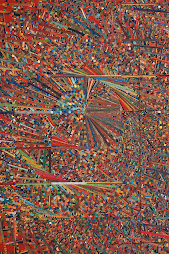
Collection of William S. Wilson



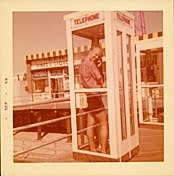
(Estate of Frances X. Profumo)
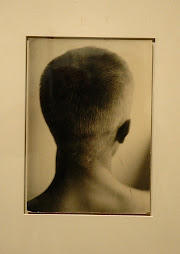
Hazel Larsen Archer (Collection of William S. Wilson and John Wronowski)
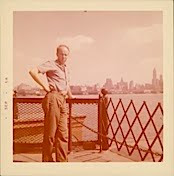
(Estate of Frances X. Profumo)
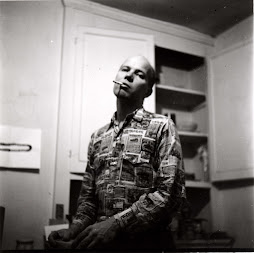
Photo by Marie T. Stilkind




A Blog for the Exhibition, From BMC to NYC: The Tutelary Years of Ray Johnson (1943-1967) Black Mountain College Museum + Arts Center, Asheville NC
February 19th - June 12th, 2010
Ray Johnson piece at Blackbird Journal
Go online to www.blackbird.vcu.edu/
in the Gallery section
to read about the recent Ray Johnson show
held last spring at the Black Mountain College Museum + Arts Center

All work of Ray Johnson on this site is used by permission of The Ray Johnson Estate
+copy.jpg)
Ray Johnson, James Dean/Rimbaud, collage on cardboard, ca. 1956-58, 11 by 7.625 inches, Private Collection
Detail from a Ray "Tesserae"

Tesserae 2, 1962 (William S Wilson)
Mat Fragment

Detail of Ladder Whirled (1952)

Collection of William S. Wilson
Links
- Asheville Vaudeville
- Barbara Cushman.com
- Black Mountain College Museum + Arts Center
- Charles Farrell, Collage
- Conversation with Ray
- Early Ray Johnson Interview in Detroit
- Essay on Ray by Mark Bloch
- Lauren LaRocca's article on Write Soon, Goon
- Merz Pictures
- Poetix Vanguard
- Raleigh Rambles
- Ray Bibliography
- Ray Exhibition from 1999, Review
- Ray Johnson - Educator
- Ray Johnson Estate
- Rayocide--67 Paragraphs on the Death of Ray Johnson
- Stealing Experience: A Collaboration in Friendship
- William S. Wilson on Ray's NYCS
MOTICOS, Shot by Avery the Imp

a Bunny Chart

Blog Archive
-
▼
2010
(139)
-
▼
January
(24)
- Just One of the Many Ray Johnson Pieces You've Nev...
- Rough Draft of Card # 5
- Krista Franklin Coming in February to Give Collage...
- Visual Poetry Workshop, February 27th at BMCM+AC
- Chicago-based Poet and Collagist, Krista Franklin
- Stay Tuned!!
- Ha Ha
- Early Altered Postcard
- from Code Word: Ray, by Kate Erin Dempsey
- Ray's Code
- Outtake from "Message(s) in a Bottle: Notes of an ...
- What is a Moticos?
- Decoder Ring
- Opening of Kate Erin Dempsey's "Code Word: Ray"
- Draft of Exhibition Poster
- Ray Mask
- "Negroes, Churches, Stars"
- Brief Excerpt from: Notes of an Unlikely Curator, ...
- Elegy for Ray
- A Peek at "Notes of an Unlikely Curator"
- Oedipus (Elvis 1), Ray Johnson
- No title
- "To Kate"
- Outtake from "Message in a Bottle: An Intro," on K...
-
▼
January
(24)
Ray's Mouth, Close Up of Archer Photo

Ray in Booth

(Estate of Frances X. Profumo)
Back of Ray's Head

Hazel Larsen Archer (Collection of William S. Wilson and John Wronowski)
Ray on Ferry

(Estate of Frances X. Profumo)
Ray in NYC Apartment

Photo by Marie T. Stilkind
detail from "Ha Ha," Collection William S. Wilson

BMC sandals


